#rainer gross
Photo










Arte Sella, the contemporary mountain.
An outdoor museum in Northern Italy, Val di Sella, Trentino.
Visited July 2019
#land art#contemporary#arte sella#rainer gross#aeneas wilder#bob verschueren#francois lelong#jaehyo lee#cédric le borgne#urs twellman#canon eos m50#ef-m 15-45mm
12 notes
·
View notes
Text

Lilies, Carnations & Stones , ca. 1980
Rainer Gross (born 1951, German)
0 notes
Photo

‘’L’Éternel Maintenant’’ (2012)_______Sculpture de Rainer Gross.
Prieuré Saint-Michel de Grandmont, France.
2 notes
·
View notes
Text
Pentiment's Complete Bibliography, with links to some hard-to-find items:
I've seen some people post screenshots of the game's bibliography, but I hadn't found a plain text version (which would be much easier to work from), so I put together a complete typed version - citation style irregularities included lol. I checked through the full list and found that only four of the forty sources can't be found easily through a search engine. One has no English translation and I'm not even close to fluent enough in German to be able to actually translate an academic article, so I can't help there. For the other three (a museum exhibit book, a master's thesis, and portions of a primary source that has not been entirely translated into English), I tracked down links to them, which are included with their entries on the list.
If you want to read one of the journal articles but can't access it due to paywalls, try out 12ft.io or the unpaywall browser extension (works on Firefox and most chromium browsers). If there's something you have interest in reading but can't track down, let me know, and I can try to help! I'm pretty good at finding things lmao
Okay, happy reading, love you bye
Beach, Alison I. Women as Scribes: Book Production and Monastic Reform in Twelfth-Century Bavaria. Cambridge Univeristy Press, 2004.
Berger, Jutta Maria. Die Geschichterder Gastfreundschaft im hochmittel alterlichen Monchtum: die Cistercienser. Akademie Verlag GmbH, 1999. [No translation found.]
Blickle, Peter. The Revolution of 1525. Translated by Thomas A. Brady, Jr. and H.C. Erik Midelfort. The Johns Hopkins University Press, 1985.
Brady, Thomas A., Jr. “Imperial Destinies: A New Biography of the Emperor Maximilian I.” The Journal of Modern History, vol 62, no. 2., 1990. pp.298-314.
Brandl, Rainer. “Art or Craft: Art and the Artist in Medieval Nuremberg.” Gothic and Renaissance Art in Nuremberg 1300-1550. The Metropolitan Museum of Art, 1986. [LINK]
Byars, Jana L., “Prostitutes and Prostitution in Late Medieval Bercelona.” Masters Theses. Western Michigan University, 1997. [LINK]
Cashion, Debra Taylor. “The Art of Nikolaus Glockendon: Imitation and Originality in the Art of Renaissance Germany.” Journal of Historians of Netherlandish Art, vol 2, no. 1-2, 2010.
de Hamel, Christopher. A History of Illuminated Manuscripts. Phaidon Press Limited, 1986.
Eco, Umberto. The Name of the Rose. Translated by William Weaver. Mariner Books, 2014.
Eco, Umberto. Baudolino. Translated by William Weaver. Mariner Books, 2003.
Fournier, Jacques. “The Inquisition Records of Jacques Fournier.” Translated by Nancy P. Stork. Jan Jose Univeristy, 2020. [LINK]
Geary, Patrick. “Humiliation of Saints.” In Saints and their cults: studies in religious sociology, folklore, and history. Edited by Stephen Wilson. Cambridge University Press, 1985. pp. 123-140
Harrington, Joel F. The Faithrul Executioner: Life and Death, Honor and Shame in the Turbulent Sixteenth Century. Farrar, Straus and Giroux, 2013.
Hertzka, Gottfired and Wighard Strehlow. Grosse Hildegard-Apotheke. Christiana-Verlag, 2017.
Hildegard von Bingen. Physica. Edited by Reiner Hildebrandt and Thomas Gloning. De Gruyter, 2010.
Julian of Norwich. Revelations of Divine Love. Translated by Barry Windeatt. Oxford Univeristy Press, 2015.
Karras, Ruth Mazo. Sexuality in Medieval Europe: Doing Unto Others. Routledge, 2017.
Kerr, Julie. Monastic Hospitality: The Benedictines in England, c.1070-c.1250. Boudell Press, 2007.
Kieckhefer, Richard. Forbidden rites: a necromancer’s manual of the fifteenth century. Sutton, 1997.
Kuemin, Beat and B. Ann Tlusty, The World of the Tavern: Public Houses in Early Modern Europe. Routledge, 2017.
Ilner, Thomas, et al. The Economy of Duerrnberg-Bei-Hallein: An Iron Age Salt-mining Center in the Austrian Alps. The Antiquaries Journal, vol 83, 2003. pp. 123-194
Lang, Benedek. Unlocked Books: Manuscripts of Learned Magic in the Medieval Libraries of Central Europe. The Pennsylvania State University Press, 2008
Lindeman, Mary. Medicine and Society in Early Modern Europe. Cambridge University Press, 2019.
Lowe, Kate. “’Representing’ Africa: Ambassadors and Princes from Christian Africa to Renaissance Italy and Portugal, 1402-1608.” Transactions of the Royal Historical Society Sixth Series, vol 17, 2007. pp. 101-128
Meyers, David. “Ritual, Confession, and Religion in Sixteenth-Century Germany.” Archiv fuer Reformationsgenshichte, vol. 89, 1998. pp. 125-143.
Murat, Zuleika. “Wall paintings through the ages: the medieval period (Italy, twelfth to fifteenth century).” Archaeological and Anthropological Sciences, vol 23, no. 191. Springer, October 2021. pp. 1-27.
Overty, Joanne Filippone. “The Cost of Doing Scribal Business: Prices of Manuscript Books in England, 1300-1483.” Book History 11, 2008. pp. 1-32.
Page, Sophie. Magic in the Cloister: Pious Motives, Illicit Interests, and Occullt Approaches to the Medieval Universe. The Pennsylvania State University Press, 2013.
Park, Katharine. “The Criminal and the Saintly Body: Autopsy and Dissectionin Renaissance Italy.” Renaissance Quarterly, vol 47, no. 1, Spring 1994. pp. 1-33.
Rebel, Hermann. Peasant Classes: The Bureaucratization of Property and Family Relations under Early Habsburg Absolutism, 1511-1636. Princeton University Press, 1983.
Rublack, Ulinka. “Pregnancy, Childbirth, and the Female Body in Early Modern Germany.” Past & Present,vol. 150, no. 1, February 1996.
Salvador, Matteo. “The Ethiopian Age of Exploration: Prester John’s Discovery of Europe, 1306-1458.” Journal of World History, vol. 21, no. 4, 2011. pp.593-627.
Sangster, Alan. “The Earliest Known Treatise on Double Entry Bookkeeping by Marino de Raphaeli.” The Accounting Historians Journal, vol. 42, no. 2, 2015. pp. 1-33.
Throop, Priscilla. Hildegarde von Bingen’s Physica: The Complete English Translation of Her Classic Work on Health and Healing. Healing Arts Press, 1998.
Usher, Abbott Payson. “The Origins of Banking: The Brimitive Bank of Deposit, 1200-1600.” The Economic History Review, vol. 4, no. 4. 1934. pp.399-428.
Waldman, Louis A. “Commissioning Art in Florence for Matthias Corvinus: The Painter and Agent Alexander Formoser and his Sons, Jacopo and Raffaello del Tedesco.” Italy and Hungary: Humanism and Art in the Early Renaissance. Edited by Peter Farbaky and Louis A. Waldman, Villa I Tatti, 2011. pp.427-501.
Wendt, Ulrich. Kultur and Jagd: ein Birschgang durch die Geschichte. G. Reimer, 1907.
Whelan, Mark. “Taxes, Wagenburgs and a Nightingale: The Imperial Abbey of Ellwangen and the Hussite Wars, 1427-1435.” The Journal of Ecclesiastical History, vol. 72, no. 4, 2021, pp.751-777.
Wiesner-Hanks, Merry E. Women and Gender in Early Modern Europe. Cambridge University Press, 2008.
Yardeni, Ada. The Book of Hebrew Script: History, Palaeography, Script Styles, Calligraphy & Design. Tyndale House Publishers, 2010.
309 notes
·
View notes
Text
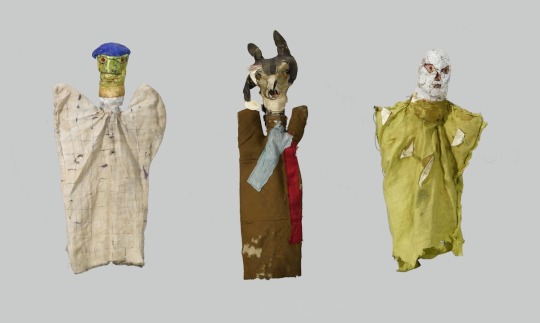
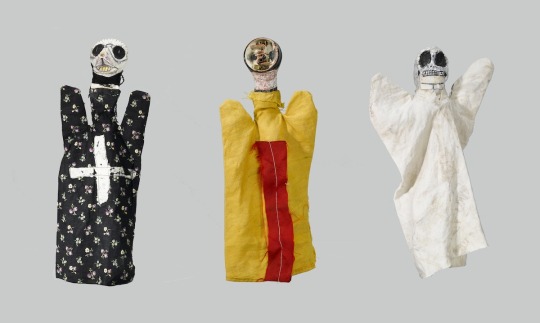

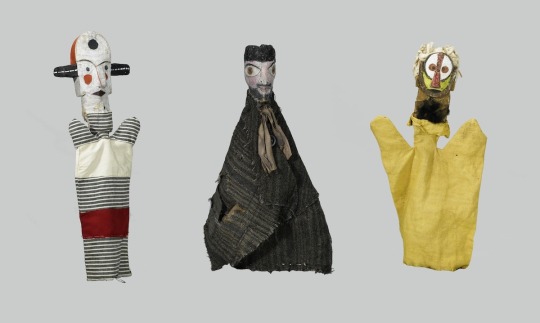
Paul Klee ( 1879-1940 )
Hand puppets.
Of Angel and Puppet
Klee, Rilke, and the Test of Innocence
By Kenneth Gross
Built for his son from the scraps of daily life — matchboxes, beef bones, nutshells, and plaster — Paul Klee’s hand puppets harbour ghosts of human feelings, fragile communications from a world most adults have left behind. Kenneth Gross compares these enchanted objects to angelic figures, in Klee’s artworks and the poetry of Rainer Maria Rilke, helping us dance as well as wrestle with their visions of innocence.
Public Domain Review
1K notes
·
View notes
Text


RAINER GROSS, The Square, 2012
Arte Sella, Trentino-Alto Adige
#arte#arte contemporanea#contemporary#contemporary art#art#digital media#mine.cd#mine.cd3#photo#photography#nature#installation#arte sella#trentino#trentino alto adige#land art#environmental art#arte ambientale
15 notes
·
View notes
Text
Do Romanced!Inquisition Characters like kissing on New Years?
I told myself I would get something out, and I intend to keep that promise. I'm gonna make a fallout one too because this was just short enough for me to do in record time
Blackwall/Thom Rainer: Yes, a quick lil' kiss. At least in public. That man is so done with the party by the time they get to the countdown. Please take him home.
Cassandra: Yes, very quick and cordial… if she initiated it. If you lean in first and control the kiss, she’s more than happy to melt.
Cullen Rutherford: Yes. It’s very loving and leaves you breathless in a nice way, like the first kiss on the battlements but with fewer soldiers interrupting you and more whooping and hollering at Cullen. However, one stare and the same soldiers are sent away with their tails between their legs.
Dorian Pavus: Yes, and he’s sure to make it last pretty long. He thinks it's funny to get a few "ews" from the party. Especially Sera, who fake gags.
Iron Bull: Yes, but then you guys kinda start making out and everyone gets grossed out. Someone yells “get a room” and Bull kinda just leads you away.
Josephine Montilyet: Yes, but on the cheek. Unless you two are away from the party, then she wants a kiss on the lips.
Sera: Yes! She’s so excited to kiss you! The second the countdown hits 1 she’s grabbing your head and just mashing you two’s faces together.
Solas: A quick peck is good unless the two of you slipped away for a while as the countdown begins. Then he gives you a nice, breathless kiss
Varric Tethras: The man was puckered up before they even started counting. He’s so ready.
#dragon age#dai#dragon age: inquisition#da:i#blackwall#thom rainier#cassandra x trevelyan#cassandra x inquisitor#cassandra pentaghast#cullen x trevelyan#cullen x lavellan#commander cullen#cullen rutherford#cullen x inquisitor#dorian x lavellan#dorian x trevelyan#dorian x inquisitor#dorian pavus#iron bull#iron bull x inquisitor#the iron bull#iron bull x adaar#iron bull x trevelyan#josephine montilyet#sera#solas dai#da solas#varric dai#varric dragon age
141 notes
·
View notes
Text
tortle's 2023 reads
persuasion by jane austen - ●●●●○
ragtime by e.l. doctorov - ●●●○○
a study in pink & the sign of the four by arthur conan doyle - ●●●○○
convenience store woman by sayaka murata - ●●●○○
jane eyre by charlotte brontë - ●●●●○
just kids by patti smith - ●●●○○
hamnet by maggie o'farrel - ●●●●○
gruppenbild mit dame by heinrich böll - ●●●●○
(rr) six of crows duology by leigh bardugo - ●●●●●
(rr) i'll give you the sun by jandy nelson - ●●●●○
in the skin of a lion by michael ondaatje - ●●●○○
brief an den vater by franz kafka - ●●●●○
when we were orphans by kazuo ishiguro - ●●○○○
one flew over the cuskoo's nest by ken kesey - ●●●○○
piranesi by suzanne collins - ●●●●●
the hundred secret senses by amy tan - ●●●●○
liebesperlen by mariana leky - ●●●●○
franny & zooey by j.d. salinger - ●●●●○
the overstory by richard powers - ●●●●●
the virgin suicides by jeffrey eugenides - ●●●●○
our wives under the sea by julia armfield - ●●●○○
everything i know about love by dolly alderton - ●●●●●
cat's cradle by kurt vonnegut - ●●●○○
untamed by glennon doyle - ●●●●○
der grosse sommer by ewald arenz - ●●●○○
(rr) mosquitoland by david arnold - ●●●●○
the grass is singing by doris lessing - ●●○○○
people person by candice carty-williams - ●●●●○
the tennant of wildfell hall by anne brontë - ●●●●○
the island of missing trees by elif shayak - ●●●●●
briefe an einen jungen dichter by rainer maria rilke - ●●●●○
white teeth by zadie smith - ●●●●○
this is how you lose the time war by amal el-mohtar and max gladstone - ●●●●○
braiding sweetgrass by robin wall kimmerer - ●●●○○
wanderer, kommst du nach spa... by heinrich böll - ●●●●○
a hundred years of solitude by gabriel garcìa marquez - ●●●○○
matrix by lauren groff - ●●●○○
daisy jones and the six by taylor jenkins reid - ●●●●○
the age of innocence by edith wharton - ●●●●○
die frau auf der treppe by bernhard schlink - ●●●●○
midnight in the garden of good and evil by john berendt - ●●●●●
joan by katherine j. chen - ●●●●○
pigs in heaven by barbara kingsolver - ●●●●●
the seven husbands of evelyn hugo by taylor jenkins reid - ●●●●○
percy jackson and the olympians (5 book series) - ●●●○○
i'm glad my mom died by jennette mccurdy - ●●●●○
(rr) the unbearable lightness of being by milan kundera - ●●●●●
the circle by dave eggers - ●●○○○
die blechtrommel by günter grass - ●●●●○
the secret history by donna tartt - ●●●●○
the hunger games (trilogy) by suzanne collins - ●●●●○
the ballad of songbirds and snakes by suzanne collins - ●●●○○
young mungo by douglas stuart - ●●●●●
ninth house by leigh bardugo - ●●●○○
last night at the telegraph club by melinda lo - ●●●○○
my book ranking system, for insight:
●●●●● -- loved loved loved this. it might have made me cry. i will be recommending this to everyone
●●●●○ -- nice!! a good read. would possibly reread and will be keeping it all pretty on my shelf
●●●○○ -- t'was a book! maybe not quite my genre or not what i needed in that moment, but no ragrets. i still got something out of it
●●○○○ -- eh. didn't really need to read this. it was kind of unoriginal and/or not my thing. will give away my copy
●○○○○ -- could not finish. who published this and why.
#as always feel free to ask about any and all of them for my review!!#it's 55 books (not counting sequels) and i am v proud#tortle reads novels
19 notes
·
View notes
Text
Am 30. Juni 2017 stimmte der Deutsche Bundestag über den Gesetzesentwurf zur "Ehe für alle" ab. Von 623 Abgeordneten (7 der eigentlich 630 Bundestagsmitglieder nahmen an der Abstimmung nicht teil) stimmten 393 für und 226 gegen die Verabschiedung des Gesetzes, welches gleichgeschlechtlichen Paaren die Eheschließung ermöglichen sollte. 4 Abgeordnete (allesamt der CDU/CSU-Fraktion angehörig) enthielten sich.
Bis auf die Stimme der fraktionslosen Abgeordneten Erika Steinbach (ursprünglich CDU, seit 2022 Mitglied der AfD) kamen alle Nein-Stimmen aus den Rängen der CDU/CSU-Fraktion, was bei 225 von 309 Abgeordneten bedeutet, dass knapp 73% der Fraktionsmitglieder gegen die "Ehe für alle" stimmten. (Ja-Stimmen gab es von ca. 24%, die Abwesenden und Enthaltungen machten zusammen ca. 3% der CDU/CSU-Stimmen aus.)
Von den 226 Abgeordneten, die damals gegen den Gesetzesentwurf zur "Ehe für alle" stimmten, amtieren zur Zeit 87 als Mitglieder des Bundestags.
Alle von ihnen sind Mitglieder der CDU/CSU-Fraktion. Im Einzelnen handelt es sich bei diesen Abgeordneten um:
Artur Auernhammer (Bayern)
Dorothee Bär (Bayern)
Thomas Bareiß (Baden-Württemberg)
Dr. André Berghegger (Niedersachsen)
Steffen Bilger (Baden-Württemberg)
Michael Brand (Hessen)
Dr. Reinhard Brandl (Bayern)
Prof. Dr. Helge Braun (Hessen)
Heike Brehmer (Sachsen-Anhalt)
Ralph Brinkhaus (Nordrhein-Westfalen)
Alexander Dobrindt (Bayern)
Michael Donth (Baden-Württemberg)
Hansjörg Durz (Bayern)
Hermann Färber (Baden-Württemberg)
Uwe Feiler (Brandenburg)
Enak Ferlemann (Niedersachsen)
Thorsten Frei (Baden-Württemberg)
Dr. Hans-Peter Friedrich (Bayern)
Michael Frieser (Bayern)
Ingo Gädechens (Schleswig-Holstein)
Hermann Gröhe (Nordrhein-Westfalen)
Michael Grosse-Brömer (Niedersachsen)
Markus Grübel (Baden-Württemberg)
Manfred Grund (Thüringen)
Oliver Grundmann (Niedersachsen)
Olav Gutting (Baden-Württemberg)
Christian Haase (Nordrhein-Westfalen)
Florian Hahn (Bayern)
Jürgen Hardt (Nordrhein-Westfalen)
Dr. Stefan Heck (Hessen)
Ansgar Heveling (Nordrhein-Westfalen)
Christian Hirte (Thüringen)
Alexander Hoffmann (Bayern)
Hubert Hüppe (Nordrhein-Westfalen)
Erich Irlstorfer (Bayern)
Thomas Jarzombek (Nordrhein-Westfalen)
Anja Karliczek (Nordrhein-Westfalen)
Ronja Kemmer (Baden-Württemberg)
Dr. Georg Kippels (Nordrhein-Westfalen)
Volkmar Klein (Nordrhein-Westfalen)
Axel Knoerig (Niedersachsen)
Jens Koeppen (Brandenburg)
Markus Koob (Hessen)
Gunther Krichbaum (Baden-Württemberg)
Dr. Günter Krings (Nordrhein-Westfalen)
Ulrich Lange (Bayern)
Paul Lehrieder (Bayern)
Dr. Andreas Lenz (Bayern)
Andrea Lindholz (Bayern)
Dr. Carsten Linnemann (Nordrhein-Westfalen)
Patricia Lips (Hessen)
Daniela Ludwig (Bayern)
Yvonne Magwas (Sachsen)
Stephan Mayer (Bayern)
Dr. Michael Meister (Hessen)
Dietrich Monstadt (Mecklenburg-Vorpommern)
Stefan Müller (Bayern)
Wilfried Oellers (Nordrhein-Westfalen)
Florian Oßner (Bayern)
Henning Otte (Niedersachsen)
Thomas Rachel (Nordrhein-Westfalen)
Kerstin Radomski (Nordrhein-Westfalen)
Alexander Radwan (Bayern)
Alois Rainer (Bayern)
Dr. Peter Ramsauer (Bayern)
Josef Rief (Baden-Württemberg)
Dr. Norbert Röttgen (Nordrhein-Westfalen)
Erwin Rüddel (Rheinland-Pfalz)
Albert Rupprecht (Bayern)
Dr. Wolfgang Schäuble (Baden-Württemberg)
Andreas Scheuer (Bayern)
Jana Schimke (Brandenburg)
Patrick Schnieder (Rheinland-Pfalz)
Detlef Seif (Nordrhein-Westfalen)
Thomas Silberhorn (Bayern)
Albert Stegemann (Niedersachsen)
Christian Freiherr von Stetten (Baden-Württemberg)
Stephan Stracke (Bayern)
Max Straubinger (Bayern)
Astrid Timmermann-Fechter (Nordrhein-Westfalen)
Dr. Volker Ullrich (Bayern)
Marco Wanderwitz (Sachsen)
Nina Warken (Baden-Württemberg)
Dr. Anja Weisgerber (Bayern)
Annette Widmann-Mauz (Baden-Württemberg)
Klaus-Peter Willsch (Hessen)
Emmi Zeulner (Bayern)
27 notes
·
View notes
Text
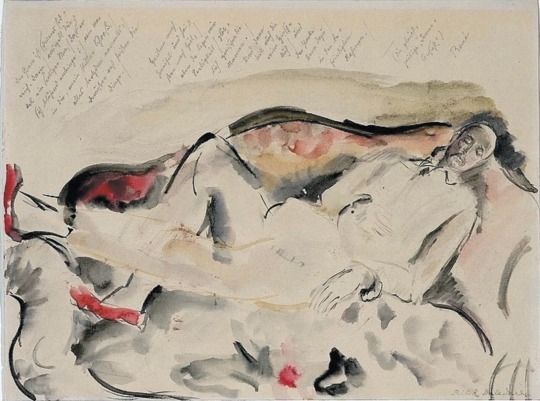
Above: Baladine Klossowska: La Contemplation Intérieure (Rilke dormant sur un petit sofa à Muzot)(1921).
* * * *
Tending my inner garden went splendidly this winter. Suddenly to be healed again and aware that the very ground of my being — my mind and spirit — was given time and space in which to go on growing; and there came from my heart a radiance I had not felt so strongly for a long time… You tell me how you are able to feel fully alive every moment of the day and that your inner life is brimming over; you write in the knowledge that what you have, if one looks at it squarely, outweighs and cancels all possible privations and losses that may later come along. It is precisely this that was borne in upon me more conclusively than ever before as I worked away during the long Winter months: that the stages by which life has become impoverished correspond with those earlier times when excesses of wealth were the accustomed measure. What, then, is there to fear? Only forgetting! But you and I, around us and in us, we have so much in store to help us remember!
Mein inneres Gärtnern war herrlich diesen Winter. Das plötzlich wieder heile Bewußtsein meiner tief bestellten Erde ergab mir eine grosse Jahreszeit des Geistes und eine lange nicht meht gekannte Stärke des Herzstrahles… Sie schreiben von dem in jedem Moment schon Erfülltsein, schon Überreichsein des inneren Daseins, von einem (wenn man nur recht zusieht) alle später möglichen Entbehrungen und Verluste schon von vornherein überwiegenden und gleichsam wiederlegenden—Besitz. Genau dies habe ich diesen langen Winter in der tiefe meiner Arbeit erfahren, mehr und unwiederruflicher, als ich es bisher wußte: daß das Leben jedem späteren Armwerden mit den seine Maße übertrefflichsten Reichtümern schon längst zuvor gekommen sei. — Was also bliebe zu fürchten? — Nur, daß man dies vergäße! Aber um uns, in uns, wieviel Hülfen zur Erinnerung!
— Rainer Maria Rilke, Letter to Lisa Heise, May 19, 1922, in Briefe, p 786.
[Robert Scott Horton]
5 notes
·
View notes
Photo


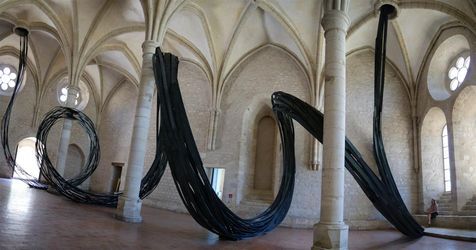
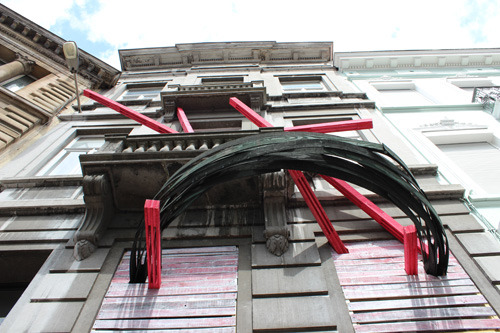




Rainer Gross
Born 1953 in Berlin (West), Germany
Since 1977 based in Brussels, Belgium
http://www.rainergross.net/
42 notes
·
View notes
Text
24-11 Die Feisten
Teddynews 24-11: die feisten Story
Rainer und C sind seit über 30 Jahren befreundet, machen gemeinsam Musik und teilen nicht zuletzt eine grosse Vorliebe für Knoblauch. Die beiden waren 25 Jahre mit dem Trio Ganz Schön Feist unterwegs, heimsten diverse Kleinkunstpreise ein und waren, wie man so schön sagt, bekannt aus Funk und Fernsehen. Mit einer bundesweit ausverkauften Abschiedstour verabschiedete sich Ganz Schön Feist von seinen Fans.
Doch die beiden fielen nicht in ein tiefes Loch, sondern vielmehr in einen kreativen Krater. Der Spass und die Lust am gemeinsamen Jammen standen und stehen für C. und Rainer schon immer an erster Stelle.
Deshalb haben sie natürlich auch nach dem Ende von G.S.F. weiter zusammen musiziert. Dabei sind nagelneue Lieder entstanden und auf einmal scharten sie jede Menge Instrumente um sich . Auf einmal wurde ihnen klar, was wäre eigentlich, wenn wir zu zweit…
Ein Schlüsselerlebnis für die beiden war ein Kurzauftritt bei einer Pop meets Classic Veranstaltung 2013 in der Braunschweiger VW Arena vor 6000 Menschen. Für diese Veranstaltung brauchten sie einen Namen: die feisten!
Eigentlich hatten sie sich einen etwas intimeren Rahmen für einen Testlauf als Duo gewünscht, aber ihre Risikobereitschaft auch auf die Klappe zu fliegen, wurde belohnt. Als sie ihren nagelneuen Song „James B." präsentierten, stand die Halle Kopf!
Ab da war klar: Ok, kann man machen! Im Prinzip brachten sie einfach das auf die Bühne, was sie schon immer zu zweit beim musizieren im Wohnzimmer taten.
Mit ihrem ersten Tourprogramm „Versuchslabor“ gingen die feisten auf die Reise durch die Republik. Langsam aber sicher erspielten sie sich ein Publikum. Durch Songveröffentlichungen auf Youtube (mit bis zu 1 Million Klicks) erreichten die beiden nicht nur ehemalige G.S.F. Fans, sondern auch unendlich viele Menschen die gar nicht wussten, dass es sowas wie die feisten überhaupt gibt.
Und wieder hagelte es Kleinkunstpreise. Als Krönung bekamen die feisten für ihr Schaffen die wohl bedeutenste Trophäe in ihrem Genre: den Deutschen Kleinkunstpreis 2017 !
Oft wird draussen gerätselt, wie geht es eigentlich drinnen bei den beiden ab? Wer macht was? Nun, C schreibt die Texte und Rainer komponiert die Musik. Bis auf einige Ausnahmen, wo sie gemeinsam an Musik und Text gearbeitet haben, ist das die Aufgabenverteilung bei den feisten.
Rainer ist Backgroundvocalartist und Multiinstrumentalist. C. ist Leadsänger und spielt Cajon, Gitarre, Ukule, Timple.
Da Rainer in Mannheim wohnt und C. in Kassel lebt, will gemeinsames musizieren jenseits der Bühne langfristig geplant werden. Mittlerweile treffen sich die beiden für die Kreativarbeit in einem Ferienhaus in Heiligenstadt, wo sie natürlich auch ihrer Vorliebe für Knoblauch freien Lauf lassen.
Hier gehts zu den Tourdaten
Gewinner Kleinkunstpreis Baden-Württemberg 2022
Tourdaten:
Instagram:
#StofftiereLindner mit #Teddynews🧸 auf Insta:
#applevisionpro#chinafactory#kuscheltiere#lindner#marketing#maskottchen#mascots#regionalwerbung#reisen#schischule#skischule#space#spacex#starship#startrek#stofftiere#stofftierelindner#stofftierhersteller#tesla#tourismus#toyfactory#visionpro#werbeartikel#werbemittel#werbung#wolfganglindner#teddynews#österreichwerbung#knowhow#diefeisten
0 notes
Text
Self-Organisation of Prediction Models
See on Scoop.it - Bounded Rationality and Beyond
Rainer Feistel
Entropy 2023, 25(12), 1596
Living organisms are active open systems far from thermodynamic equilibrium. The ability to behave actively corresponds to dynamical metastability: minor but supercritical internal or external effects may trigger major substantial actions such as gross mechanical motion, dissipating internally accumulated energy reserves. Gaining a selective advantage from the beneficial use of activity requires a consistent combination of sensual perception, memorised experience, statistical or causal prediction models, and the resulting favourable decisions on actions. This information processing chain originated from mere physical interaction processes prior to life, here denoted as structural information exchange. From there, the self-organised transition to symbolic information processing marks the beginning of life, evolving through the novel purposivity of trial-and-error feedback and the accumulation of symbolic information. The emergence of symbols and prediction models can be described as a ritualisation transition, a symmetry-breaking kinetic phase transition of the second kind previously known from behavioural biology. The related new symmetry is the neutrally stable arbitrariness, conventionality, or code invariance of symbols with respect to their meaning. The meaning of such symbols is given by the structural effect they ultimately unleash, directly or indirectly, by deciding on which actions to take. The early genetic code represents the first symbols. The genetically inherited symbolic information is the first prediction model for activities sufficient for survival under the condition of environmental continuity, sometimes understood as the “final causality” property of the model.
Read the full article at: www.mdpi.com
Alessandro Cerboni's insight:
Gli organismi viventi sono sistemi aperti attivi lontani dall’equilibrio termodinamico. La capacità di comportarsi attivamente corrisponde alla metastabilità dinamica: effetti interni o esterni minori ma supercritici possono innescare azioni sostanziali importanti come il movimento meccanico grossolano, dissipando le riserve di energia accumulate internamente. Ottenere un vantaggio selettivo dall’uso benefico dell’attività richiede una combinazione coerente di percezione sensuale, esperienza memorizzata, modelli di previsione statistica o causale e le conseguenti decisioni favorevoli sulle azioni. Questa catena di elaborazione delle informazioni ha avuto origine da semplici processi di interazione fisica precedenti alla vita, qui indicati come scambio di informazioni strutturali. Da lì, la transizione auto-organizzata verso l’elaborazione simbolica delle informazioni segna l’inizio della vita, evolvendosi attraverso la nuova finalità del feedback per tentativi ed errori e l’accumulo di informazioni simboliche. L'emergere di simboli e modelli di previsione può essere descritto come una transizione di ritualizzazione, una transizione di fase cinetica che rompe la simmetria del secondo tipo precedentemente noto dalla biologia comportamentale. La nuova simmetria correlata è l’arbitrarietà, la convenzionalità o l’invarianza del codice neutralmente stabile dei simboli rispetto al loro significato. Il significato di tali simboli è dato dall’effetto strutturale che alla fine scatenano, direttamente o indirettamente, decidendo quali azioni intraprendere. Il primo codice genetico rappresenta i primi simboli. L’informazione simbolica ereditata geneticamente è il primo modello di previsione per attività sufficienti per la sopravvivenza in condizioni di continuità ambientale, talvolta intesa come proprietà di “causalità finale” del modello.
0 notes
Text
one thing that pisses me off the most about people calling petscop an arg or a creepypasta is that like. not only do those words have Meaning but also bc its just. gross to boil down a story about dealing with awful childhood trauma years into adulthood + learning to choose your family and embrace the people in your life that you actually feel safe around into being a creepypasta or arg just bc its somewhat unsettling and on the internet. not to say that there arent creepypastas and args that tackle these themes + tackle them well, but w/ how the broader internet views these things (moreso with creepypastas) its just gross. this is a story about a man finding a video game made by his family to document the fucked up shit that went on in that family. it was the last and possibly only thing rainer worked on before dissappearing, possibly killing themself. it was the last thing lina did before dissappearing. and though i dont think shes gone and i think that the ending implies shes still alive and with paul and belle, that also could just not be the case. its about paul finding this game that his aunt; who raised him like he was her son Because of the events in the game; that he views her as his mother bc she might as well be; made with his cousin that was possibly made so that he could refind it in the future and properly deal with his trauma as an adult. or perhaps to tell their story through a game that never got a chance to be published. its about him finding this game and him recording himself playing this game so he could show his sister. its about his family discovering that hes doing this and deciding to take control of his life. its him breaking free from this cycle at the end and being able to properly process his childhood. its a lot more than just. a creepypasta or an arg. its a story. a story that is told in a confusing way
0 notes
Text
youtube
Felix Draeseke (1835-1913) : Grosse Messe in F-Sharp Minor, Op.60 (1890-1891)
00:00 Kyrie 06:35 Gloria 18:06 Credo 35:22 Sanctus 43:12 Agnus Dei
Adelheid Vogel, soprano Elvira Dreszen, contralto Frieder Lang, tenor Philipp Langshaw, bass
Evangelische Jugendkantorei der Pfalz and Kölner Philharmoniker conducted by Udo-Rainer Follert, (German radio broadcast in 1989)
1 note
·
View note
Note
48, 49
Who would they say ‘yes’ to if invited to do something they abhorred / strongly didn’t want to do?
Hel, Ariadne, Tess, Hermes, Artemis, Shangqi, Rainer (probably), Bast- it tends to be close friends or just specific individuals in general that they are able to bear deeply unpleasant and/or not interested kind of things.
If they are helping someone - they are willing to do that for a more general scope of individuals.
Would they eat something they find gross to be polite?
Yes, because Saima has figured out they are wrong about what they think is gross. They've actually found out some new dishes that they liked despite initially being a little wary of them.
0 notes